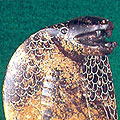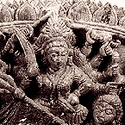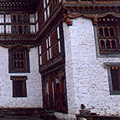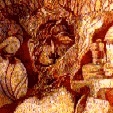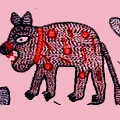Stone Icon Carving of Pondicherry,
Tamil Nadu is a well known for the carving of stone sculptures and icons at Swamimalai, Ramanathapuram, Trunelveli, Tiruchirapalli, Thanjavur and Kanyakumari districts. Stone icons are also made in Gopichettipalayam and Satyamangalam in Salem district and Tiruvannamalai which are also noted for local stone carvings. The village of Madayur near Vellore is known for folk-style small carvings of humans, animals, birds and reptiles. The stone artisans are called as Sthapathis and they belong to the Viswakarma community. These carvers are also known as Kamalas, a corruption of the word kannalan (one who gives or rules the eye) perhaps because they carve the eyes last, as only then does the figure assumes its entity. They use traditional methods of stone carving, using the proportions prescribed in the Shilpa Shastra. They are polished by hand to give the figures a good patina and high shine. Rubbing with wax is also done to give the figures a lustrous appearance. One of the specialties of stone carving at Tamil Nadu is the depiction of animal and bird life. This is especially seen in the carvings at Mahabalipuram. One common animal is the Yali, a combination of an elephant and a lion widely found in South Indian cosmology
Tamil Nadu is a well known for the carving of stone sculptures and icons at Swamimalai, Ramanathapuram, Trunelveli, Tiruchirapalli, Thanjavur and Kanyakumari districts. Stone icons are also made in Gopichettipalayam and Satyamangalam in Salem district and Tiruvannamalai which are also noted for local stone carvings. The village of Madayur near Vellore is known for folk-style small carvings of humans, animals, birds and reptiles. The stone artisans are called as Sthapathis and they belong to the Viswakarma community. These carvers are also known as Kamalas, a corruption of the word kannalan (one who gives or rules the eye) perhaps because they carve the eyes last, as only then does the figure assumes its entity. They use traditional methods of stone carving, using the proportions prescribed in the Shilpa Shastra. They are polished by hand to give the figures a good patina and high shine. Rubbing with wax is also done to give the figures a lustrous appearance. One of the specialties of stone carving at Tamil Nadu is the depiction of animal and bird life. This is especially seen in the carvings at Mahabalipuram. One common animal is the Yali, a combination of an elephant and a lion widely found in South Indian cosmology
Stone Icon Carving of Tamil Nadu,
Tamil Nadu is a well known for the carving of stone sculptures and icons at Swamimalai, Ramanathapuram, Trunelveli, Tiruchirapalli, Thanjavur and Kanyakumari districts. Stone icons are also made in Gopichettipalayam and Satyamangalam in Salem district and Tiruvannamalai which are also noted for local stone carvings. The village of Madayur near Vellore is known for folk-style small carvings of humans, animals, birds and reptiles. The stone artisans are called as Sthapathis and they belong to the Viswakarma community. These carvers are also known as Kamalas, a corruption of the word kannalan (one who gives or rules the eye) perhaps because they carve the eyes last, as only then does the figure assumes its entity. They use traditional methods of stone carving, using the proportions prescribed in the Shilpa Shastra. They are polished by hand to give the figures a good patina and high shine. Rubbing with wax is also done to give the figures a lustrous appearance. One of the specialties of stone carving at Tamil Nadu is the depiction of animal and bird life. This is especially seen in the carvings at Mahabalipuram. One common animal is the Yali, a combination of an elephant and a lion widely found in South Indian cosmology
Tamil Nadu is a well known for the carving of stone sculptures and icons at Swamimalai, Ramanathapuram, Trunelveli, Tiruchirapalli, Thanjavur and Kanyakumari districts. Stone icons are also made in Gopichettipalayam and Satyamangalam in Salem district and Tiruvannamalai which are also noted for local stone carvings. The village of Madayur near Vellore is known for folk-style small carvings of humans, animals, birds and reptiles. The stone artisans are called as Sthapathis and they belong to the Viswakarma community. These carvers are also known as Kamalas, a corruption of the word kannalan (one who gives or rules the eye) perhaps because they carve the eyes last, as only then does the figure assumes its entity. They use traditional methods of stone carving, using the proportions prescribed in the Shilpa Shastra. They are polished by hand to give the figures a good patina and high shine. Rubbing with wax is also done to give the figures a lustrous appearance. One of the specialties of stone carving at Tamil Nadu is the depiction of animal and bird life. This is especially seen in the carvings at Mahabalipuram. One common animal is the Yali, a combination of an elephant and a lion widely found in South Indian cosmology
Stone Icon Carving of West Bengal,
The karangas of Bankura and Sildah in Midnapur make a large variety of stone utensils from a local semi-soft grey stone of close grain. Different sizes and designs of cups, bowls, plates, and tumblers are finished on indigenous lathes operated by hand after their general shapes are roughly chiselled out of lumps of stone. Traditionally there were beautifully shaped and patterned soft stone moulds for cookies, fresh cheese, chhana, sweets, and amsatwa or cakes of dried mango juice. Flat plates with delicate floral patterns on them were made of stone by the karangas. The plates are still made but the floral designs are no longer there. Carved stone figures for temples and home shrines are made by the sutradhars of Dainhata village in Burdwan district. Sutradhar sculptors also worked in stone to carve panels and plaques for temples in Birbhum district, following the style of terracottas. The panels and plaques were carved in a local brick-red stone called phulpathar. Phulpathar temples are about 200 years old and the art was lost before the end of the 19th century. The karangas of Bankura and Sildah in Midnapur make a large variety of stone utensils from a local semi-soft grey stone of close grain. Different sizes and designs of cups, bowls, plates, and tumblers are finished on indigenous lathes operated by hand after their general shapes are roughly chiselled out of lumps of stone. Traditionally there were beautifully shaped and patterned soft stone moulds for cookies, fresh cheese, chhana, sweets, and amsatwa or cakes of dried mango juice. Flat plates with delicate floral patterns on them were made of stone by the karangas. The plates are still made but the floral designs are no longer there. Carved stone figures for temples and home shrines are made by the sutradhars of Dainhata village in Burdwan district. Sutradhar sculptors also worked in stone to carve panels and plaques for temples in Birbhum district, following the style of terracottas. The panels and plaques were carved in a local brick-red stone called phulpathar. Phulpathar temples are about 200 years old and the art was lost before the end of the 19th century. In the Susunia hills of Bankura district there are renowned archaeological sites with multiple stone articles which were made and used centuries ago. Weapons like axe, cutter, hamme have also been found. In this area the craft of stone carving is still present with utensils, utilitarian objects, sculptures of gods and goddesses, owls, horse and other objects being sculpted in white sand stone. The craftsmen of this area have received prestigious at both State and National levels, yet their livelihood continues to be at a unacceptable low level. There is lack of proper infrastructure, lack of financial aid and encouragement, lack of sponsors and minimal guidance for marketing and a ban on quarrying the rocks with National level awardees shifting to wood carving or other occupations, while many craftspeople have migrated to other States.
The karangas of Bankura and Sildah in Midnapur make a large variety of stone utensils from a local semi-soft grey stone of close grain. Different sizes and designs of cups, bowls, plates, and tumblers are finished on indigenous lathes operated by hand after their general shapes are roughly chiselled out of lumps of stone. Traditionally there were beautifully shaped and patterned soft stone moulds for cookies, fresh cheese, chhana, sweets, and amsatwa or cakes of dried mango juice. Flat plates with delicate floral patterns on them were made of stone by the karangas. The plates are still made but the floral designs are no longer there. Carved stone figures for temples and home shrines are made by the sutradhars of Dainhata village in Burdwan district. Sutradhar sculptors also worked in stone to carve panels and plaques for temples in Birbhum district, following the style of terracottas. The panels and plaques were carved in a local brick-red stone called phulpathar. Phulpathar temples are about 200 years old and the art was lost before the end of the 19th century. The karangas of Bankura and Sildah in Midnapur make a large variety of stone utensils from a local semi-soft grey stone of close grain. Different sizes and designs of cups, bowls, plates, and tumblers are finished on indigenous lathes operated by hand after their general shapes are roughly chiselled out of lumps of stone. Traditionally there were beautifully shaped and patterned soft stone moulds for cookies, fresh cheese, chhana, sweets, and amsatwa or cakes of dried mango juice. Flat plates with delicate floral patterns on them were made of stone by the karangas. The plates are still made but the floral designs are no longer there. Carved stone figures for temples and home shrines are made by the sutradhars of Dainhata village in Burdwan district. Sutradhar sculptors also worked in stone to carve panels and plaques for temples in Birbhum district, following the style of terracottas. The panels and plaques were carved in a local brick-red stone called phulpathar. Phulpathar temples are about 200 years old and the art was lost before the end of the 19th century. In the Susunia hills of Bankura district there are renowned archaeological sites with multiple stone articles which were made and used centuries ago. Weapons like axe, cutter, hamme have also been found. In this area the craft of stone carving is still present with utensils, utilitarian objects, sculptures of gods and goddesses, owls, horse and other objects being sculpted in white sand stone. The craftsmen of this area have received prestigious at both State and National levels, yet their livelihood continues to be at a unacceptable low level. There is lack of proper infrastructure, lack of financial aid and encouragement, lack of sponsors and minimal guidance for marketing and a ban on quarrying the rocks with National level awardees shifting to wood carving or other occupations, while many craftspeople have migrated to other States.
Stone Utensils of Keonjar, Odisha,
These stone utensils are mainly found in the centres of Lulung and Bolgariah of Keonjhar district. They are made by using a hand-turned lathe. The design and shape of these utensils is very unique. These utensils are valued for religious purposes and are also supposed to have a curative medicinal effect on diabetic patients.
These stone utensils are mainly found in the centres of Lulung and Bolgariah of Keonjhar district. They are made by using a hand-turned lathe. The design and shape of these utensils is very unique. These utensils are valued for religious purposes and are also supposed to have a curative medicinal effect on diabetic patients.
Stone Work or Masonry – Dozo,
Traditional architecture in Bhutan is characterized by the use of natural local materials such as rammed earth, bamboo, local timbers, and stone and has adapted to the local topography, climatic conditions and most importantly, cultural traditions and religious beliefs. Stone arts are used in the construction of the outer walls of large fortresses (Dzongs), temples (Lhakhangs), monasteries (Goenpas), stupas (choetens), palaces, and other buildings.
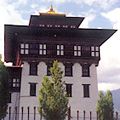
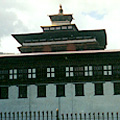
Traditional architecture in Bhutan is characterized by the use of natural local materials such as rammed earth, bamboo, local timbers, and stone and has adapted to the local topography, climatic conditions and most importantly, cultural traditions and religious beliefs. Stone arts are used in the construction of the outer walls of large fortresses (Dzongs), temples (Lhakhangs), monasteries (Goenpas), stupas (choetens), palaces, and other buildings.
Dzongs
The Dzongs (fortresses), located in each valley in Bhutan at strategic places, with their massive stone walls, large courtyards and beautiful wood work on windows and cornices are the most striking among the diverse architectural expressions of the country.
The making of these stone walls gave rise to a craft of its own, stone masonry. The task was to work a block out of a rock, which fits next to, and on top of, another stone. The senior master-mason (zope) makes the plans and supervises the angles in building a wall.

Stupas
The most common architectural feature of Bhutan's countryside is the chorten or stupa. A chorten literally means a receptacle of worship or offering. Following his cremation, the relics of the Buddha were divided among eight groups of claimants, each of which erected a reliquary. This marked the origin of these structures, which came to be known as stupas. While initially stupas were meant only to house the relics of the Buddha and other Buddhist saints, later they acquired a deeper significant and symbolism. Building a stupa came to be considered an act of great piety, earning merit for the actual builders as well as for those who paid for them. A stupa is not considered as an inanimate objects but as a support of faith.
Chortens are sometimes linked by long thick stone walls called mani (prayer walls, which are inscribed with religious paintings and prayers).

Houses
The construction materials and the plan of the house differ from region to region - depending on the climate and the topography. Although normal indigenous houses of farmers were two stories high, an ideal house was one that had three main floors and an attic, with each level having distinctive functions.
Houses in Southern Bhutan are ridged roofed and rectangular with outer walls of stones and rammed mud finished with plaster. The inner walls are of closely woven bamboo matting.
In Bumthang houses of stone rather that rammed earth and more sparsely decorated. In the East, houses are built traditional Bhutanese style but one can see many made of bamboo matting and raised on stilts. The semi nomadic Yak herders of Lungshi, Laya in the Northern areas build dry stone walled houses.
Walls are made of stone and wood or stone, wood and rammed earth. Thick rammed earth or stone masonry walls create formally enclosed volumes of spaces which resonate having escape out to the exterior through very narrow timber window on the lower floors and larger elaborately painted timber windows on the top floor.
State buildings are now using hollow cement blocks for walls.
Stool / Muda and Mat Making,
Mats like gundri, jhalla, and sukul, which are commonly used in the rural areas are made of some varieties of dried wheat, paddy straw, and jute yarn. These are locally made within the households. In the terai, especially in the eastern part, muda - a variety of stool for sitting on - is made of strips of bamboo and cane. The products are crafted mainly by the women; a number of home-based women in the Jhapa district are engaged in making the muda.
Mats like gundri, jhalla, and sukul, which are commonly used in the rural areas are made of some varieties of dried wheat, paddy straw, and jute yarn. These are locally made within the households. In the terai, especially in the eastern part, muda - a variety of stool for sitting on - is made of strips of bamboo and cane. The products are crafted mainly by the women; a number of home-based women in the Jhapa district are engaged in making the muda.
Straw and Jute Shoes,
Made and worn by the jyapu farmer caste of the Newari community, this unusual straw footwear can be seen on the feet of the women working in the fields in winter.
Made and worn by the jyapu farmer caste of the Newari community, this unusual straw footwear can be seen on the feet of the women working in the fields in winter.
PROCESS
The straw shoes are made up of two pieces: an upper part and a sole. While the front and heel sections are made up separately, three plaited bands of straw are stitched together to form the approximately 3 cm thick sole. To weave the upper part, two-ply warp strands of straw are stitched in and looped around the outer edge of the sole. These warp strands are kept in place by straw strands all around for several rounds. The shape of the shoe is maintained by varying the thickness of the straw weft. The shoe is finished with a row of sisal-strands.
The jute shoes are constructed in a similarly to the straw shoes; however, in these the sole is made up of three to four thick, jute-wrapped straw bundles that are wrapped, coiled, and interlaced rather than plaited. The bundles are tapered to form a neat point at the toe.
Straw Craft of Kerala,
Straws ranging in colour from dark-brown to brownish-yellow are selected. The work is done on a cardboard covered with crepe-silk or khadi cloth. The sketch is first outlined on the crepe-board and then the paddy strands are parted along the lines of the sketch. Fine blades are used to cut the straw.
Straws ranging in colour from dark-brown to brownish-yellow are selected. The work is done on a cardboard covered with crepe-silk or khadi cloth. The sketch is first outlined on the crepe-board and then the paddy strands are parted along the lines of the sketch. Fine blades are used to cut the straw.
Straw Picture Craft in Goa,
Straws ranging in colour from dark-brown to brownish-yellow are selected. The work is done on a cardboard covered with crepe-silk or khadi cloth. The sketch is first outlined on the crepe-board and then the paddy strands are parted along the lines of the sketch. Fine blades are used to cut the straw.
Straws ranging in colour from dark-brown to brownish-yellow are selected. The work is done on a cardboard covered with crepe-silk or khadi cloth. The sketch is first outlined on the crepe-board and then the paddy strands are parted along the lines of the sketch. Fine blades are used to cut the straw.
String Puppet Folk Art of Maharashtra,
String puppet folk art of Maharashtra is form of Thakar tribal art forms. The other art forms of this style of folk art include: Leather Puppet (Shadow Puppet) Chitrakatha Pangul Bael Pingli Pothraja Gondhal Dona Geet(song) Radha Nrutya
String puppet folk art of Maharashtra is form of Thakar tribal art forms. The other art forms of this style of folk art include: Leather Puppet (Shadow Puppet) Chitrakatha Pangul Bael Pingli Pothraja Gondhal Dona Geet(song) Radha Nrutya
String Puppets of Karnataka,
String puppetry shows in Karnataka are based on the popular local folk-drama called yakshagana; the doll-show or puppet-show is called as bombeyatta. The Sanskrit yaksh-yakshini are known as jakka-jakkini in Kannada. The puppets are shaped out of light wood capable of being worked into smooth surfaces. The face, with the headgear, the neck, and the hands and feet are artistically carved. The wooden frame of each puppet has joints at the neck, shoulders, elbows, hips, and knees. The neck is inserted loosely into the chest and tied with a twine a couple of times to allow easy all-round movements. The puppets range in height from an average of 22 inches to 28 inches. The female characters have elaborate hair styles decorated with imitation of local flowers and jewellery made of wood that is carved and painted or covered with tinsel and beads. The headgear of the maleshas is an elaborate turban shaped like the golden-hued ketaki, a highly scented flower with a multi-sheath pod and the forehead is adorned with a jewel. The female puppet wears the traditional sari and blouse and the male wears the dhoti and a red kurta. The figures are covered with jewellery. Lord Krishna is made to wear a golden-yellow cloth and is armed with chakra and a bow and arrow. The most striking is the bannada vesha or demon-villain. The kireeta or crown is unusually .big in size and the back has a circular and coloured ponytail. The total height of the figure, including headgear, is 32 inches.
String puppetry shows in Karnataka are based on the popular local folk-drama called yakshagana; the doll-show or puppet-show is called as bombeyatta. The Sanskrit yaksh-yakshini are known as jakka-jakkini in Kannada. The puppets are shaped out of light wood capable of being worked into smooth surfaces. The face, with the headgear, the neck, and the hands and feet are artistically carved. The wooden frame of each puppet has joints at the neck, shoulders, elbows, hips, and knees. The neck is inserted loosely into the chest and tied with a twine a couple of times to allow easy all-round movements. The puppets range in height from an average of 22 inches to 28 inches. The female characters have elaborate hair styles decorated with imitation of local flowers and jewellery made of wood that is carved and painted or covered with tinsel and beads. The headgear of the maleshas is an elaborate turban shaped like the golden-hued ketaki, a highly scented flower with a multi-sheath pod and the forehead is adorned with a jewel. The female puppet wears the traditional sari and blouse and the male wears the dhoti and a red kurta. The figures are covered with jewellery. Lord Krishna is made to wear a golden-yellow cloth and is armed with chakra and a bow and arrow. The most striking is the bannada vesha or demon-villain. The kireeta or crown is unusually .big in size and the back has a circular and coloured ponytail. The total height of the figure, including headgear, is 32 inches.
Stringing of Pote – Beads,
Though not technically a craft since the pote or bead is imported into Nepal, the stringing of pote into traditional necklaces by expert craftsmen has been a ritual for more than a hundred years.
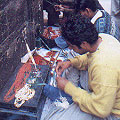
Though not technically a craft since the pote or bead is imported into Nepal, the stringing of pote into traditional necklaces by expert craftsmen has been a ritual for more than a hundred years.
TRADITIONS
'The pote is symbolic of the delicate nature of a marriage,' says Saguddin, a master at stringing and selling the pote necklaces. 'It is said that each bead ensures a year of blissful married life. A typical pote usually consists of around 2,000 beads - more than enough to sustain a couple of lifetimes of conjugal happiness.'
The beads are more than ornamental - the wearing of the beads immediately identifies the caste of the wearer. The amount of gold in the tilhari indicates the wealth of the groom. Brides of the chettri or warrior caste wear several long strings of green beads with a big tilhari. It is worn over the right shoulder and under the left arm with the gold tilhari dangling over the left waistline. Brides of the Rana and Shah clans also wear thick yellow pote together with the tilhari.

DETAILS
The loose beads are imported from the Czech Republic, Germany, and Japan - they come in every colour imaginable. The simple design is usually custom-made at the pote bazaar itself after customers choose the quality and colour of the beads to be used. The Czech beads are considered to be of high quality though German and Japanese varieties are also equally well liked. The price depends on the quality of the glass, the colour, and the cutting. Round and hexagonal beads are the most popular, while the square and diamond-shaped ones are less favoured. Red is considered auspicious and hence is the most preferred colour, followed by green and then yellow.
PRACTITIONERS & LOCATIONS
The Kashmiri Muslims at Rakhi Bazaar in Indrachowk, Kathmandu have been involved in the trading of these bead necklaces since they settled in Kathmandu some hundred years ago. Previously, bead working was done by this small community themselves. But lately, they have been employing about 800 home-based women workers living in Sunargoan and Machhegaon areas of Kathmandu to do this work at their own homes as per specified designs.
THE TOURIST MARKET
Beads also make exquisite, but inexpensive, fashion accessories as well as excellent souvenirs. In fact, many a tourist is seen at the pote bazaar hunting for gifts to take back home. They ask the bead stringers to made bracelets, anklets, and even belts out of the exotic and pretty beads.
Sujani Weaving/Quilts of Gujarat,
Bharuch is the only craft pocket of Sujani weaving in Gujarat. In this process, two weavers sit at either ends and operate the loom. A shuttle of two colours is passed in the warp threads with the intention of turning the warp and the weft. While weaving, spun cotton is inserted and woven in squares. The history of Sujuni weaving dates back to the 1860s when a Bharuch native learnt this craft form from a fellow Assamese convict in the Andaman jail and later taught it to his villagers. This meticulous technique involves two weavers per loom who place cotton between two layers of thread and weave them all together. Soft colored checks in contrast with bright colored stripes in a textured surface define the feel of the Sujuni fabric, which is both warm and durable. Around 30 artisans practice this highly skilled trade today. Sujani quilt-making craft originated in Bharuch, Gujarat and has since then travelled across the globe, The quilts are known for their unique texture and patterns on the surface. When Baruch was under the Nawab empire, sujani quilts would be created with rose petals, henna petals and other leaves to provide a soft texture and exquisite fragnances. Sujani quilting with cotton is directly done with looms and requries high level of specialised skill. The process is laborious and complicated. There needs to be a honeycomb pattern that has to be made by the warp and weft threads of the fabric. Inside the honeycomb spaces cotton fibre is filled, producing checkered patterns. The weft and warp are made of colourful and vibrant colours which add to their appeal.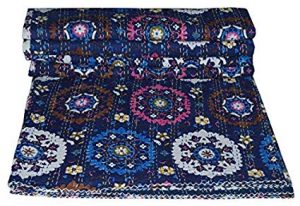
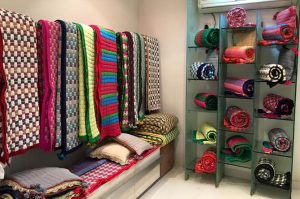
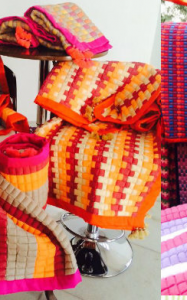
Bharuch is the only craft pocket of Sujani weaving in Gujarat. In this process, two weavers sit at either ends and operate the loom. A shuttle of two colours is passed in the warp threads with the intention of turning the warp and the weft. While weaving, spun cotton is inserted and woven in squares. The history of Sujuni weaving dates back to the 1860s when a Bharuch native learnt this craft form from a fellow Assamese convict in the Andaman jail and later taught it to his villagers. This meticulous technique involves two weavers per loom who place cotton between two layers of thread and weave them all together. Soft colored checks in contrast with bright colored stripes in a textured surface define the feel of the Sujuni fabric, which is both warm and durable. Around 30 artisans practice this highly skilled trade today. Sujani quilt-making craft originated in Bharuch, Gujarat and has since then travelled across the globe, The quilts are known for their unique texture and patterns on the surface. When Baruch was under the Nawab empire, sujani quilts would be created with rose petals, henna petals and other leaves to provide a soft texture and exquisite fragnances. Sujani quilting with cotton is directly done with looms and requries high level of specialised skill. The process is laborious and complicated. There needs to be a honeycomb pattern that has to be made by the warp and weft threads of the fabric. Inside the honeycomb spaces cotton fibre is filled, producing checkered patterns. The weft and warp are made of colourful and vibrant colours which add to their appeal.



Sujini Kantha Embroidery of Bihar,
Sujuni embroidery, a craft from the Muzaffarnagar district of Bihar, is used to create furnishing fabrics, bedspreads, wall hangings, cushion and bolster covers, as well as clothing items like sarees, dupattas and kurtas. Initially the designs depicted the daily life of the people as well as their natural surroundings; increasingly, however, comments about social and political issues have been incorporated in the patterns. The themes range from village life and the Hindu epics to concerns about election violence, the education of girls and lessons in healthcare. Sujuni is distinctive for its transformation of a traditional craft into a vehicle for expressing contemporary social and political themes. These narratives proclaim that social change is the essence and purpose of the craft revival.
Sujuni embroidery, a craft from the Muzaffarnagar district of Bihar, is used to create furnishing fabrics, bedspreads, wall hangings, cushion and bolster covers, as well as clothing items like sarees, dupattas and kurtas. Initially the designs depicted the daily life of the people as well as their natural surroundings; increasingly, however, comments about social and political issues have been incorporated in the patterns. The themes range from village life and the Hindu epics to concerns about election violence, the education of girls and lessons in healthcare. Sujuni is distinctive for its transformation of a traditional craft into a vehicle for expressing contemporary social and political themes. These narratives proclaim that social change is the essence and purpose of the craft revival.
Symbols of Bhutan,
Commonly used symbols in Bhutan and their significance

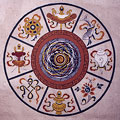


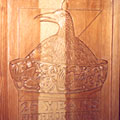
Commonly used symbols in Bhutan and their significance
DRAGON (DRUK)
Bhutan, often referred to as the Druk Yul, or the Land of the Thunder Dragon takes its name from the druk or the Thunder Dragon, a mythical animal revered by the Bhutanese as the symbolic guardian of the country. Legend goes that Tsangpa Gyare Yesga Dorji (1161-1211) was consecrating a new monastery in Tibet when he heard the sound of thunder. Taking it to be the call of the dragon he named the monastery Druk and his school of religious thought came to be known as the Drukpa. When Bhutan was unified, by Shabdrung Ngawang Namgyel, a lama of the Drukpa school, it came to be known as Druk Yul or the Land of the Thunder Dragon.
The dragon can be found on Bhutan's national flag, the royal crest and in many paintings in temples and buildings. In fact the word druk has come to be synonymous with all things Bhutanese - it is the name used by the National Airlines; it is also the trade mark for fruit juices, jams and other commodities.
In the National Flag, the upper part of the flag's golden yellow colour represents the secular power of the king, the lower orange part symbolises the Buddhist religion and the white dragon represents the country of Bhutan itself - its purity; the jewels held in its claw stand for the wealth and perfection of the country.

ROYAL CREST (DRUK KHATAP)
The official seal or Royal Crest of Bhutan has two dragons, and in between in the centre is the crossed dorje (vajra/thunderbolt). The sacred jewel at the top of the crest signifies the supremacy of the sovereign in the Buddhist Kingdom of Bhutan.
The dorje jadram or 'Crossed Thunderbolt' (vajra) at the centre symbolises the harmonious relationship between traditional customs of spiritual law and modern authority.
The two male and female thunder dragons (druk) guarding the crossed thunderbolts represent the two deities protecting the country's religion and people from inimical outside forces.

EIGHT AUSPICIOUS SIGNS (TASHI TAGYE)
In a certain configuration, the eight auspicious signs represent the different parts of Lord Buddha's body (viz. the vase of immorality represents the throat, the lotus represents the tongue, the fishes represent the eyes and so on). The signs are extensively used as decorations in Bhutan. They are painted on the ceilings and pillars in buildings and also carved in metal or wood. They also feature on the reverse of the tikchung coin in circulation in Bhutan.
- The Treasure Vase (bumpa) symbolises the contents of the Buddhist doctrine, treasures that will overcome all desires on the part of its believers.
- The Endless Knot (pay-yap or drami) stands for depth of mind, thinking and love.
- The Victorious Banner (gyaltshen) proclaims the victory of Enlightenment and Buddhism and virtue over vice.
- The Wheel of Law (khorlo) represents the propagation of the Buddha's teachings - and as it moves symbolises that the Buddhist doctrines are alive and flourishing.
- The Golden Parasol (ser dhug) symbolises the authority of the Buddha's teachings. Just as the parasol offers protection from the sun, the Dharma also protects people's spirits from evil.
- The Golden Fish (sergi nya) keep their eyes wide open in spite of the water and they have knowledge of obstacles and objectives. Similarly, the Buddhist doctrine allows the faithful to act correctly in the world and achieve happiness and realisation of truth.
- The White Conch (dung kar): The sound of it signifies the propagation of the Buddhist doctrine and the reverberating sound of Dharma.
- The Lotus Flower (meto pema) connotes non-attachment. As the lotus is never stained with the mud in which it grows, so a pure conscience does not remain attached to samsara or life of this world.

FOUR HARMONIOUS SIBLINGS (THUENPA PUNZHI)
The fable of the four harmonious siblings is said to have been told by the Buddha himself to promote Buddhist virtues. The composition illustrates the harmonious relationship among four siblings (elephant, monkey, rabbit, and bird), and their co-operation with each other - the strong support the weak and they all unite together to make a tree grow.
THE TAG (TIGER),SINGHE (SNOW LION), CHUNG (GARUDA) AND DRUK (DRAGON)
The tag (tiger), singhe (snow lion), chung (garuda) and druk (dragon) can often be seen painted together outside buildings. These four animals bring good luck. Garuda, the mythical sun eagle - Vishnu's vehicle (Vishnu is a Hindu divinity) is also owned by Vajrayana Buddhism and associated with Vajrapani. The famous Chinese pilgrim, Husan Tsang mentions that Vajrapani was connected with subduing the gigantic snake in Uddiyana. It is also believed that when the serpents came to listen to the Buddha's sermons, it was Vajrapani's duty to protect them from their mortal enemy, the garuda. To do so, Vajrapani assumed the shape of a garuda and is thus depicted on the top of the Prabhavalis of important Buddhist divinities.

THE SIX SYMBOLS OF LONG LIFE (TSHERING DRUKOR)
This image depicts the symbols of longevity and brings good luck. They are:
- The long edged rocky cliff;
- The long spring/river;
- The long leafed tree;
- The old ascetic (depicting long human life)
- The long necked bird;
- The long horned deer of long life

THE RAVEN (MAHAKALA)
This represents the deity Gonpo Tarodonchen (Mahakala with a raven's head) one of the most important guardian deities of Bhutan.
